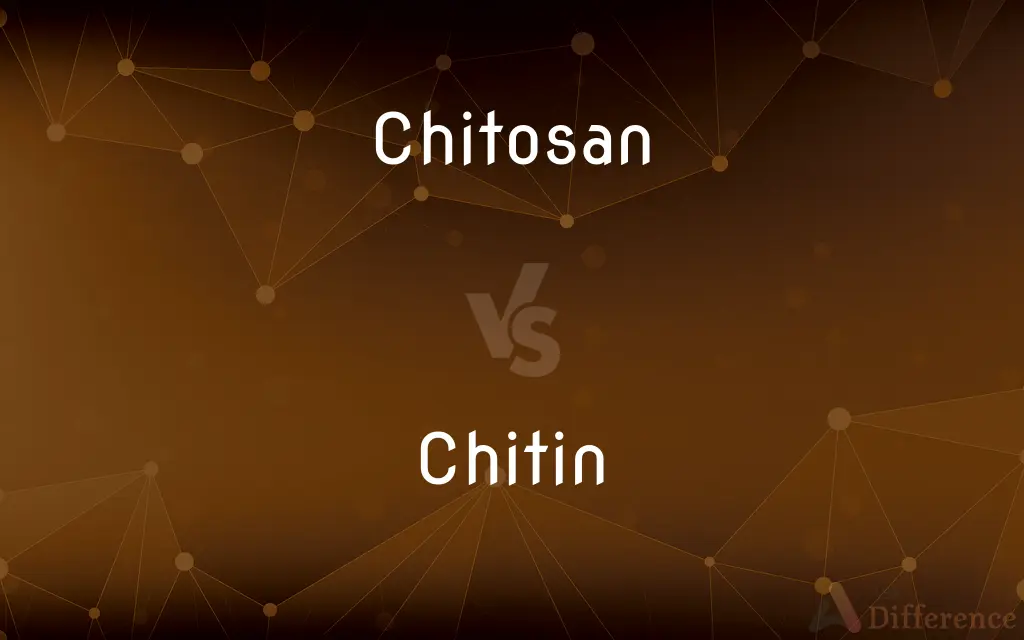Chitosan vs. Chitin — What's the Difference?
By Tayyaba Rehman & Fiza Rafique — Updated on March 10, 2024
Chitosan is derived from chitin, a component in the exoskeleton of crustaceans, modified to enhance solubility in water; chitin is a natural polymer, tough and found in arthropods.

Difference Between Chitosan and Chitin
Table of Contents
ADVERTISEMENT
Key Differences
Chitin is a large, structural polysaccharide made from chains of modified glucose. It forms part of the exoskeletons of crustaceans, insects, and the cell walls of fungi, providing rigidity and structural integrity. Chitosan, on the other hand, is a derivative of chitin obtained through the deacetylation process, where acetyl groups are removed from chitin.
While chitin is primarily found in the structural components of organisms, chitosan's uses extend into more varied fields due to its modified properties. Chitosan's bioactive properties, such as biocompatibility, biodegradability, and antimicrobial activity, make it a valuable material in various fields.
The extraction of chitin typically involves the removal of calcium carbonate, proteins, and other substances from crustacean shells. This is a resourceful way of utilizing waste from the seafood industry. Chitosan is then produced by treating chitin with an alkaline substance to remove the acetyl groups, a process that adjusts its properties and enhances its utility.
Chitin's tough, semi-transparent, and flexible nature is crucial for the protective roles it plays, whereas chitosan's solubility allows it to be used in drug delivery systems, wound dressings, and biodegradable plastics.
Comparison Chart
Composition
Polysaccharide made from modified glucose.
Derived from chitin by deacetylation.
ADVERTISEMENT
Solubility
Insoluble in water and most solvents.
Soluble in acidic solutions to form a gel.
Source
Exoskeletons of crustaceans, insects, and fungi cell walls.
Produced from chitin by alkaline deacetylation.
Applications
Structural component in nature.
Medicine, biotechnology, water treatment, food preservation.
Properties
Tough, rigid, semi-transparent.
Biocompatible, biodegradable, antimicrobial.
Compare with Definitions
Chitosan
Insoluble in water, providing rigidity.
Chitin's insolubility makes it perfect for protective purposes in nature.
Chitin
Water-soluble derivative of chitin.
Chitosan's water solubility makes it ideal for biomedical applications.
Chitosan
A structural polysaccharide found in arthropods.
Chitin gives strength to the crab's exoskeleton.
Chitin
Used in drug delivery systems.
Chitosan is used to encapsulate drugs for controlled release.
Chitosan
Main component of fungal cell walls.
Fungi utilize chitin to maintain cell wall integrity.
Chitin
Purifies water by removing pollutants.
Chitosan is employed in water treatment processes to capture heavy metals.
Chitosan
Extracted for chitosan production.
Chitin from shrimp shells is processed to produce chitosan.
Chitin
Acts as a biodegradable plastic.
Chitosan-based materials offer an eco-friendly alternative to conventional plastics.
Chitosan
Essential for the exoskeletons of insects.
Insects rely on chitin for their hard outer shells.
Chitin
Enhances wound healing.
Chitosan dressings support rapid and effective wound healing.
Chitosan
Chitosan is a linear polysaccharide composed of randomly distributed β-(1→4)-linked D-glucosamine (deacetylated unit) and N-acetyl-D-glucosamine (acetylated unit). It is made by treating the chitin shells of shrimp and other crustaceans with an alkaline substance, such as sodium hydroxide.
Chitin
Chitin (C8H13O5N)n ( KY-tin) is a long-chain polymer of N-acetylglucosamine, an amide derivative of glucose. This polysaccharide is a primary component of cell walls in fungi, the exoskeletons of arthropods, such as crustaceans and insects, the radulae of molluscs, cephalopod beaks, and the scales of fish and skin of lissamphibians, making it the second most abundant polysaccharide in nature, behind only cellulose.
Chitosan
(carbohydrate) An oligosaccharide derived from chitin, sometimes used in the absorption of fat
Chitin
A fibrous substance consisting of polysaccharides, which is the major constituent in the exoskeleton of arthropods and the cell walls of fungi.
Chitin
A nitrogen-containing polysaccharide that is a tough, protective, semitransparent substance and is the principal component of arthropod exoskeletons and the cell walls of certain fungi.
Chitin
(carbohydrate) A complex polysaccharide, a polymer of N-acetylglucosamine, found in the exoskeletons of arthropods and in the cell walls of fungi; thought to be responsible for some forms of asthma in humans.
Chitin
A white amorphous horny substance forming the harder part of the outer integument of insects, crustacea, and various other invertebrates; entomolin.
Chitin
A tough semitransparent horny substance; the principal component of the exoskeletons of arthropods and the cell walls of certain fungi
Common Curiosities
Why is chitosan valuable in various industries?
Chitosan's biocompatibility, biodegradability, and antimicrobial properties make it valuable in medicine, biotechnology, and environmental applications.
How is chitosan related to chitin?
Chitosan is derived from chitin through a deacetylation process that removes acetyl groups, making it soluble in water and altering its properties.
Can chitin be dissolved in water?
No, chitin is insoluble in water and most organic solvents due to its structural composition.
How does chitosan contribute to agriculture?
Chitosan acts as a natural growth enhancer and protects plants against pathogens.
What distinguishes chitosan's applications from chitin's?
Chitosan's applications are more varied due to its solubility and bioactive properties, extending beyond the structural uses of chitin.
What makes chitosan a good material for wound dressings?
Chitosan promotes blood clotting and has antimicrobial properties, supporting wound healing.
What is chitin?
Chitin is a natural polysaccharide found in the exoskeletons of crustaceans, insects, and the cell walls of fungi, providing structural support.
How is chitosan used in water treatment?
Chitosan can remove pollutants, including heavy metals and dyes, from water due to its binding capabilities.
What industries benefit from chitin and chitosan?
The pharmaceutical, agricultural, food preservation, water treatment, and bioplastic industries benefit from chitin and chitosan.
What is the significance of chitosan's solubility?
Chitosan's solubility in acidic environments makes it versatile for various applications, unlike insoluble chitin.
What are the main uses of chitin?
Chitin is primarily used for its structural properties in nature and as a precursor for chitosan production.
Is chitosan environmentally friendly?
Yes, chitosan is biodegradable and made from renewable resources, making it an eco-friendly material.
How are chitin and chitosan extracted?
Chitin is extracted from crustacean shells, and chitosan is produced by deacetylating chitin with an alkaline substance.
Can chitosan be used in food packaging?
Yes, chitosan can be used in food packaging to extend shelf life due to its antimicrobial properties.
Are chitin and chitosan safe for human use?
Yes, both are considered safe and have been used in various applications, including medical devices and food products.
Share Your Discovery

Previous Comparison
Gable vs. Dormer
Next Comparison
Presume vs. AssumeAuthor Spotlight
Written by
Tayyaba RehmanTayyaba Rehman is a distinguished writer, currently serving as a primary contributor to askdifference.com. As a researcher in semantics and etymology, Tayyaba's passion for the complexity of languages and their distinctions has found a perfect home on the platform. Tayyaba delves into the intricacies of language, distinguishing between commonly confused words and phrases, thereby providing clarity for readers worldwide.
Co-written by
Fiza RafiqueFiza Rafique is a skilled content writer at AskDifference.com, where she meticulously refines and enhances written pieces. Drawing from her vast editorial expertise, Fiza ensures clarity, accuracy, and precision in every article. Passionate about language, she continually seeks to elevate the quality of content for readers worldwide.
















































